mm Calibration Strategies for the MNRF upgrade
1. Introduction & "straw-man model" (Ray Norris)
I propose a "Minimum Straw-Man model", in which
- the 3 mm and 12 mm feeds are mounted on the turret so that either can be brought on to the optical axis by normal turret rotation, and we have no other mechanical receiver translator (other than normal turret rotation and antenna pointing),
- there is no frequent turret rotation (other than for normal band changes between observing projects)
- when observing at 3 mm, we make 12 mm calibration observations from the offset position occupied by the normal 12 mm feed, giving ~1-2 dB loss on the 12 mm performance in this mode
- we drive to a pointing and baseline calibrator every 5 minutes, and observe it using the offset 12 mm feed
- we drive to an atmospheric phase calibrator every minute, and observe it using the offset 12 mm feed
- we make continuous water-vapour measurements around 22 GHz using the offset 12 mm feed
- when making astronomical 12 mm observations (as opposed to calibration 12 mm observations) we rotate the turret to put the 12 mm feed on-axis.
Clearly, this minimum straw-man model is desirable in terms of cheapness and simplicity, compared to more elaborate models requiring additional translators or dichroics. If there are no good reasons for going to more elaborate models, then we should go to this minimum.
In this meeting we need to
1. see whether we need to go to something more elaborate than this,
2. reach consensus where possible on strategies and observing parameters,
3. identify areas where more work is needed before we can make an informed decision.
2. The phase correction problem (Bob Sault)
Parcels of moist air result in different excess path and lengths through the atmosphere.
Model calculations (assuming a Kolmogorov spectrum) for short and long baselines give the following results:
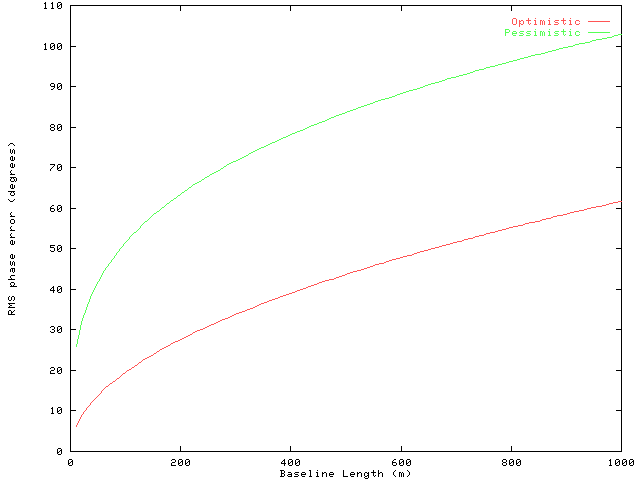
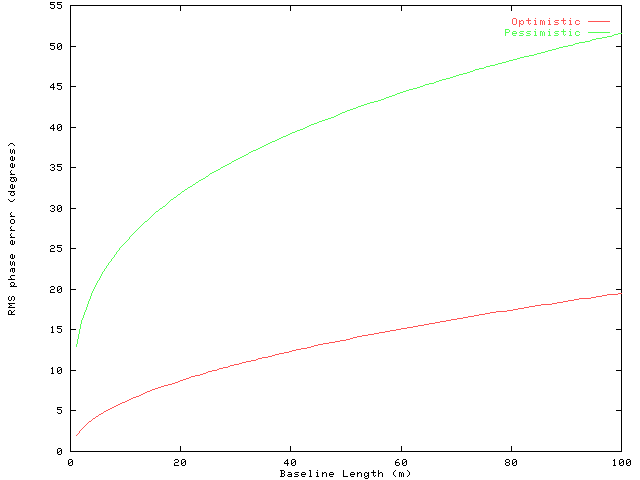
From this work, it appears that on about 25% of winter nights, the ATCA could be used to make images at baselines up to 100m with no special phase calibration other than the normal calibrators at 20-min intervals used at lower frequencies. The aim of further phase calibration to be discussed in this meeting is to increase this 25% and also to allow the use of longer baselines.
Calibration Approaches
- There are four calibration techniques, and we will probably use a combination of these for different circumstances:
- Traditional phase calibration/fast switching
- Water vapour radiometry
- self-calibration
- paired-antenna calibration.
Water vapour Radiometry
Assume:
- Brightness Temperature of Atmosphere is proportional to Water Vapour Content
- Wet Excess Path is proportional to Water Vapour Content
Errors in Water Vapour Radiometry
- Normal thermal S/N limits (not normally significant)
- Instrumental (single dish systematic) errors
- Modelling errors
The 22 GHz water vapour line has a sensitivity of about 8 mm/K, where the 8 mm is the excess path and the K refers to the measured increase in antenna temperature due to the water vapour. At Narrabri, the water vapour gives a typical excess path of 50-100 mm, but only about 1% of that is variable.
Normal Phase Calibration/Fast switching
- This is the normal technique used at lower frequencies, in which the antennas are regularly switched between source and calibrator. There are two distinct sources of error:
- calibrator phase differs from source phase because of their angular separation compared to scale size of fluctuating screen (independent of wind speed and switching time)
- calibrator phase differs from source phase fluctuating screen moves during measurement (depends on wind speed and switching time)
- Typical necessary switching times are:
- 20 cm - once a day
- 3.5 mm - every 5 sec
Phase errors have been estimated as a function of switching times and wind speeds:
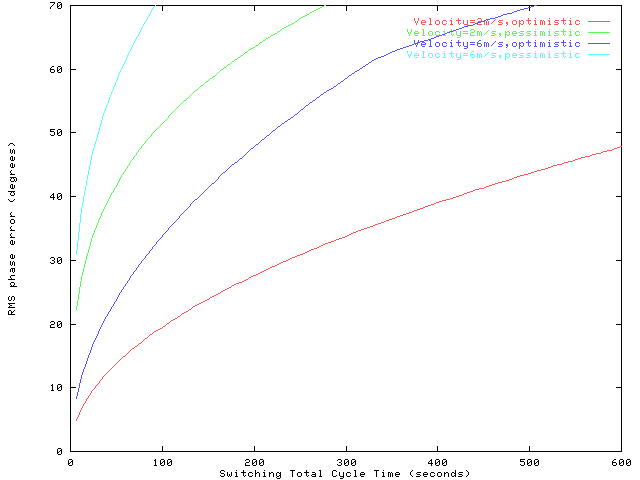
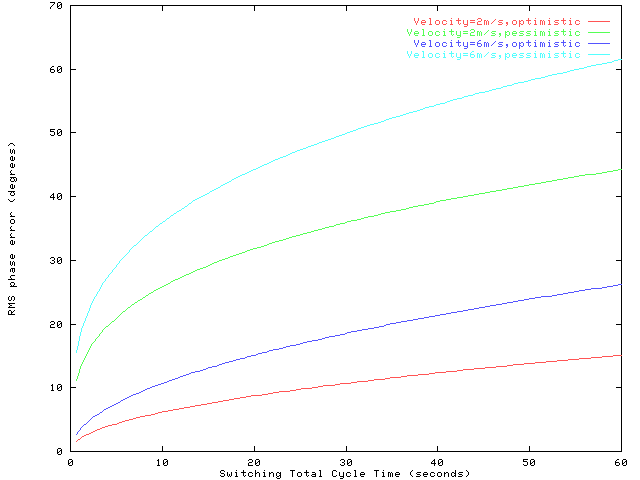
The distribution of wind speeds is known from met records:
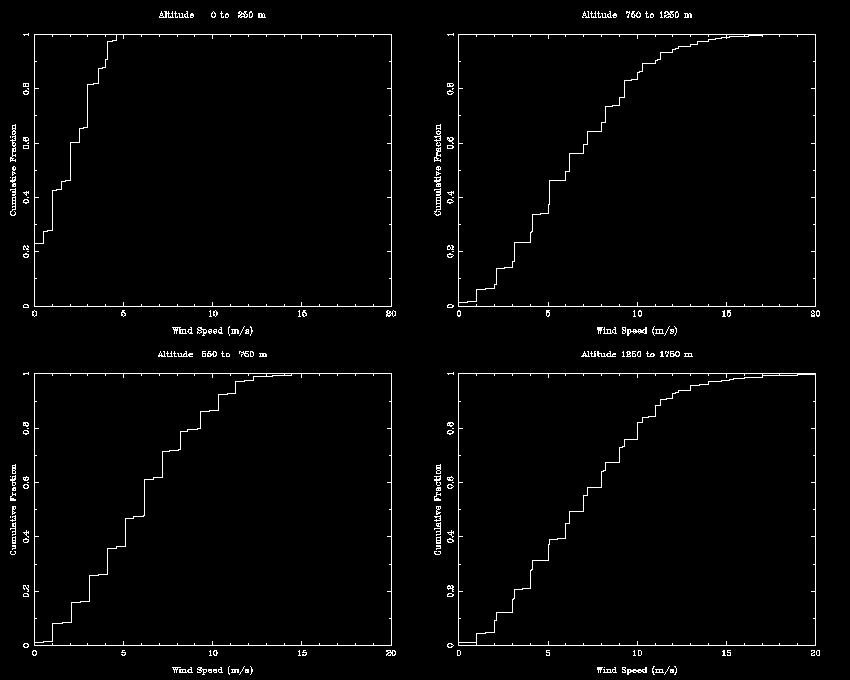
Consequently, a 200s switching time gives a phase error in the region 20-100 degrees. Thus switching times of order 1 minute are typically necessary.
Depending on the scale length of the phase screen, the distance to the nearest calibrator will also introduce a phase error (even in the absence of wind):
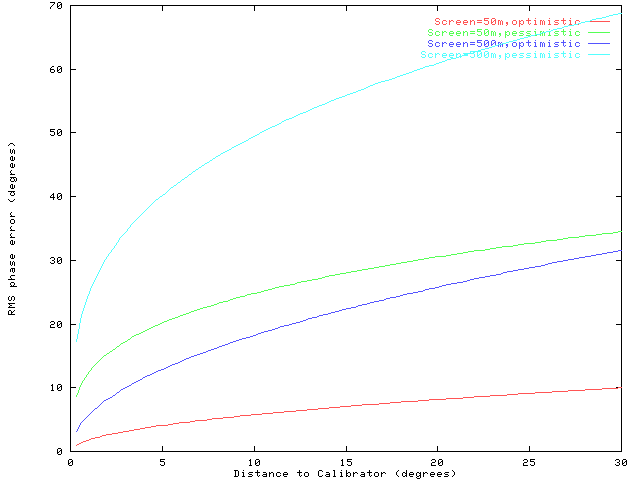
Thus calibrators need to be within 5-10 degrees of target sources.
3.5 vs 12 mm Phase Calibration
When observing a phase calibrator, the resulting calibration error depends on the source strength S , and the system temperature Tsys :
Sensitivity to Excess Path is proportional to S /Tsys
Two additional factors are:
- if the calibrator source is observed at 12 mm, then the calibration phase needs to be multiplied up to 3 mm, thus increasing the calibration error.
- If the 12 mm feed is in an offset position, there will be a loss of about 1.8 dB in sensitivity.
Typical effective (i.e. above atmosphere, at zenith) system temperatures are:
| Tsys | |
| 12 mm on-axis | 1150 Jy |
| 12 mm off-axe | 1750 Jy |
| 3.5 mm GaAs | 4150 Jy |
| 3.5 mm InP | ?? |
Given these factors, and the apparently relatively large numbers of calibrators at 3 mm, it may actually be preferable to use calibrators at 3 mm instead of 12 mm. For 12 mm off-axis/3.5 mm GaAs, 3.5 mm phase calibration is preferable if source spectral index is flatter than ~ -0.3 .
Unknowns
- How well is water vapour radiometry going to work??
- What is the near-field response of the ATCA antennas at 22 GHz?
- What is the near-field response when the 12 mm feed is off-axis?
- Is Mark Holdaway's analysis of 3.5 mm calibrators correct?
- Where is the turbulent layer?
Further Work
- More work on understanding modelling errors in water vapour radiometry
- Work out or measure statistics of 3 mm calibrators (can be done in Northern Hemisphere)
- Develop calibrator grid? (Needs to be done in Southern Hemisphere - use 2-antenna prototype 3 mm interferometer?)
3. Water-vapour radiometer specifics (Peter Hall)
Introductory Reading
Participants should scan the papers:
Lay, O. P., "The temporal power spectrum of atmospheric fluctuations due to water vapour", Astron. Astrophys. Suppl. Ser. 122, pp. 535-545 (1997)
Lay, O. P., "Phase calibration and water vapour radiometry for millimetre-wave arrays", ibid., pp. 547-557.
In these reviews, Oliver Lay gives a good exposition of current thinking on mm-calibration and its tie-in to water vapour radiometry. The timescales and orders of magnitudes he discusses may also aid thinking.
22 GHz Feed Performance
The question of how well the 22 GHz feed performs off-axis is crucial. Its far-field performance (presently suggested gain loss of ~ 2 dB) is critical to astronomical calibration while its near-field performance determines whether it's useful for water vapour sensing. A recently-commissioned CTIP study will provide insight into both questions (results due end of Nov). Measurements by Mal Sinclair at Mopra suggest that the off-axis performance will be acceptable in both areas. It is important that more measurements be done soon and that Mal have the necessary computing/operations support at Mopra.
PJH believes that the performance of the offset 22 GHz feed is a critical issue. Its near-field performance determines whether we can do radiometry when observing at 3mm. Its far-field performance determines whether we can do astronomical observing and, by implication, calibration (should the spectral index statistics lead us to want to cal at 22 GHz).
Calibrator Statistics
Knowledge of the statistics of calibration source spectra are critical in determining whether there is any advantage in trying to calibrate 3mm observations with 22 GHz astronomical calibrators. This question is also central in the design of new-generation mm arrays. There is a fairly small body of work on the subject (which Bob Sault talked about). However, I strongly recommend that the ATNF be involved in science programs designed to *measure* cal source spectra - even a measured sample of northern sources using operating arrays would be useful in deriving spectral index statistics. If it turns out that there is no advantage in source numbers and brightness at 22 GHz, we can certainly eliminate the need for a Dewar translator.
PJH believes that the AT needs to be proactive in answering the calibration source spectral-index statistical questions...the answers determine in large measure whether we calibrate primarily at 12 or 3 mm.
Water Vapour Radiometry
The radiometric correction works in a shorter time regime than fast position switching and, in principle, allows phase correction under a range of poorer observing conditions (faster phase variations). If the off-axis performance of the 22 GHz feed is OK, calibration of the radiometric correction should be possible via the normal astronomy calibration cycle, providing the cycle is "sensible" (1 to 5 min, depending on the ultimate radiometer performance).
To help pin down some parameters in the atmospheric model we use for path length (phase) retrieval, we will co-operate with the Division of Atmospheric Research to get some balloon radiosonde launches from the Narrabri site. Hopefully, these balloons can carry the DAR's "high resolution" probes which allow better vertical sampling of the lower atmosphere. Although detailed atmospheric modelling is not central in our applications, good models give more information about atmospheres at the Observatory and allow more refined specifications of, e.g., WLM filter frequencies.
Measuring the location of the water vapour turbulence is much more difficult. The UNSW will, if ARC funding eventuates, purchase an ultrasonic radar (SODAR) which they have offered us for 6 months or so prior to its deployment in Antarctica. We have offered to co-supervise a student wishing to gain experience with the instrument in anticipation that radar probing will give us definitive information on turbulence - the first for any mm array site.
The 225 GHz WVR will go to Narrabri in 2 weeks (G. Carrad organising). This will also be invaluable in atmospheric characterisation, especially when used in conjunction with Moree (and later Narrabri) radiosonde launches.
The point of the atmospheric investigations at Narrabri is to give us (a) better seeing statistics (opacity and stability) but also (b) to help us determine some Narrabri-specific parameters in the path-length (phase) retrieval process from the remote sensing (radiometry). Also, it is probable that these Narrabri-specific investigations couple into the initial specs of a 22 GHz water line monitor (e.g. filter centre frequencies and bandwidths).
Other Points:
- P. Hall will visit Owens Valley and IRAM next month to assess phase correction progress, particularly in the application of the OVRO 22 GHz water line monitor.
- The timescale for an ATNF decision on radiometric phase correction routes is still early 1998
- For clouds (liquid water) the problem becomes quite different, and we do not yet have expertise in this area - need to follow progress of Woody group. We should regard this as a bonus if it works, rather than as an integral part of our calibration strategy.
- If we use the 22 GHz receiver as a WVR, we need to see whether the proposed AT receiver architecture is likely to meet the 1 part in 10^4 stability requirement over periods of minutes. If not, Mal et al will need to consider other architectures and/or calibration schemes
4. Conclusion and round-table discussion
- Consensus is that at this stage it is looking likely that the "straw-man" model will work, and that the translator will not be needed. It's likely that phase calibration can be done at 3 mm, but even if it can't then phase calibration at 12 mm using the offset feed is probably OK.
- However, important to make the measurements here to firm up the estimates.
Actions
- MWS to measure the "1.8 dB" with more certainty - with help from MJK?
- PJH/MWS to check on gain stability of VSOP Receiver - can it be used for WVR?
- RJS to study source statistics to see if 3 mm calibrators can be used, and model source-calibrator separations at different elevations.
- 3 mm science group to put in a BIMA & VLA proposal to get statistics on 12 mm and 3 mm calibrators.
- JWB to study wear-and-tear effects on the antennas (from 1-min switch cycles)
- Last updated: 24-Nov-1997
Ray Norris (rnorris@atnf.csiro.au)
